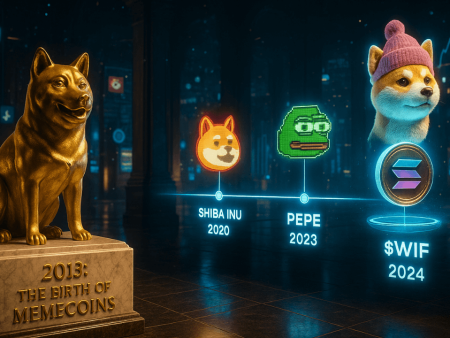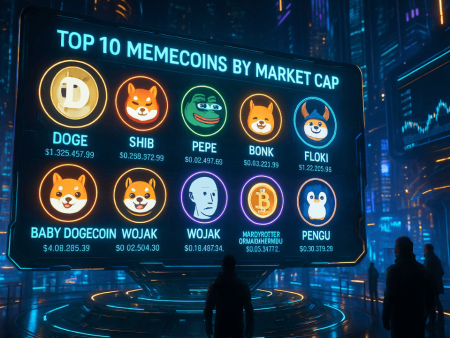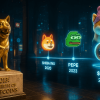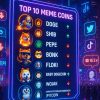Table of Contents
ToggleWhat Are Meme Coins?
Think of meme coins as the internet’s inside jokes that became tradable tokens. They are crypto assets driven less by technological innovation and more by community energy, online culture, and viral marketing. While Bitcoin aims to be “digital gold” and Ethereum powers decentralized applications, meme coins often thrive on humor, speculation, and hype. They can soar in value with a single viral post, but they can also crash just as quickly. Institutions call them speculative, while communities call them fun. Both perspectives contain truth.
A Brief History of Meme Coins
The first widely recognized meme coin was Dogecoin (DOGE). It launched in December 2013 and was created by Billy Markus and Jackson Palmer. Dogecoin began as a parody of the crypto craze but quickly became beloved for its Shiba Inu mascot and playful community spirit. What started as a joke grew into a digital tipping system on Reddit and Twitter, funding everything from the Jamaican bobsled team’s trip to the 2014 Winter Olympics to clean water projects in Africa. Its community-driven energy and lighthearted culture gave Dogecoin staying power beyond its initial joke status.
In 2020, Shiba Inu (SHIB) entered the scene as the so-called “Doge Killer.” Unlike Dogecoin, SHIB launched with an entire ecosystem in mind. It introduced ShibaSwap (a decentralized exchange), additional tokens such as BONE and LEASH, and later its own Layer 2 network called Shibarium. Shibarium incorporated token-burning mechanisms and cheaper transactions, which gave SHIB a stronger claim to utility. This transition from pure meme to meme-plus-functionality set SHIB apart from most meme coins that simply rely on temporary hype.
More recently, meme coins have moved to Layer 2 platforms with lower fees and faster speeds. In 2024, BRETT became the first meme coin on Coinbase’s Base chain to reach a one billion dollar market capitalization. This was a signal that meme coins were finding fertile ground on scalable chains where community-driven projects can flourish quickly. While this milestone does not make BRETT a safe investment, it demonstrates how fast new meme narratives can gain traction when combined with low-cost trading environments.
How Meme Coins Differ from Traditional Cryptocurrencies
Aspect | Meme Coins | Bitcoin or Ethereum (Traditional) |
Core driver | Community sentiment, memes, virality | Monetary policy (Bitcoin) and smart-contract platform (Ethereum) |
Utility | Often minimal at launch, may add staking, burns, or L2s later | Payments, decentralized finance, NFTs, and dApps |
Volatility | Extremely high, often reacting to tweets or viral posts | High but more connected to fundamentals |
Tokenomics | Usually massive token supplies, sometimes deflationary burns | Bitcoin has a capped supply, Ethereum has staking and token burning after the Merge |
Risk profile | Elevated risk due to thin liquidity, pump and dumps, rug pulls | Still risky, but more institutional support and adoption |
In summary, meme coins are usually speculation-first assets that may evolve into “meme-plus-utility” over time. Investors should view them more as a cultural experiment or entertainment vehicle than a reliable long-term store of value. Regulators consistently warn that meme coins are prone to manipulation, volatility, and scams.
Are Meme Coins Just a Joke or Something More?
The truth is that meme coins are both.
Still a joke (and that is fine): Many meme coins exist solely to capitalize on viral moments. They are created quickly, gain short-term attention, and fade once the excitement ends. While that makes them risky, it also means early adopters can sometimes experience massive short-term gains.
Sometimes more: A few meme coins attempt to create real ecosystems with features like staking, decentralized exchanges, non-fungible tokens, and token-burning mechanisms. SHIB, for example, has moved closer to becoming a utility-driven project with Shibarium and its deflationary token model.
New frontiers: Layer 2 ecosystems are opening new ground for meme coins. BRETT’s success on Base showed that meme projects can thrive in environments with low fees and active communities. However, the same speed that enables rapid growth also accelerates downturns when interest fades.
Why Meme Coins Go Viral
The Power of Social Media Hype
Meme coins thrive in the same environment where TikTok dances and Twitter hashtags explode overnight. A single viral post, meme remix, or trending hashtag can send a coin’s price skyrocketing. Traders often buy into the story rather than the fundamentals. FOMO, or fear of missing out, drives demand as people rush to get in early before “the next Dogecoin” takes off.
Elon Musk and Celebrity Influence
Celebrities have tremendous influence on meme coin markets. Elon Musk tweeting about Dogecoin, even casually, has triggered massive price surges. Politicians and influencers occasionally push niche meme coins, further driving speculation. While this may generate meteoric rises, it often results in equally fast crashes once attention shifts.
Memes, Communities, and Internet Culture
At the heart of meme coins lies community engagement. Platforms like Reddit, Discord, and Telegram allow communities to rally behind a token. Inside jokes, shared memes, and a sense of belonging create cult-like loyalty. Some meme coins leverage this community loyalty as if it were gold, using it as the foundation for their survival and growth.
Low Entry Barriers and Affordability
Many meme coins are priced at fractions of a cent. This low entry point allows small investors to feel like early adopters who could potentially ride a wave to wealth. The idea that “anyone can buy millions of tokens with a small investment” democratizes access, even if the returns are uncertain.
Strategic Listings on Exchanges
When meme coins get listed on major centralized exchanges like Binance or Coinbase, trading volume and visibility often skyrocket. The combination of momentum and exchange exposure acts like rocket fuel. Exchange listings are often turning points that push meme coins from niche communities into mainstream visibility.

Top 10 Performing Memecoins Of 2025
Using market-cap data and social metrics (as of early September 2025):
- Dogecoin (DOGE): The original meme titan still dominates. Market cap: ~\$33B.
- Shiba Inu (SHIB): The “Dogekiller” with DeFi and burn utility. Market cap: ~$7–8B.
- Pepe (PEPE): The frog coin turned sensation. ~\$4B market cap; higher daily trading volumes than SHIB.
- Bonk (BONK): Solana’s community meme choice. Strong activity and market share.
- Pudgy Penguins (PENGU): From NFTs to memecoin, backed by institutional interest. ~$1.9B cap.
- Official Trump (TRUMP): Political meme coin with an ETF filing in the works. ~$1.7B cap.
- SPX6900 (SPX): Funny and volatile, riding meme-culture momentum. ~$1.16B cap.
- FARTCOIN (FARTCOIN): Offbeat and viral. ~$0.8B cap.
- Dogwifhat (WIF): A Solana meme with cultural reach, still trending. ~$0.8B cap.
- BRETT (BRETT): A newer meme coin on Ethereum L2, combining utility and humor. ~$450M cap.
Quick note: Newer presale sensations like Little Pepe (LILPEPE) and Layer Brett (technically separate) are drawing real buzz but are not yet in the top 10 by cap.
How to Discover New Meme Coins Early
Tracking Trending Hashtags and Mentions
Active traders often monitor Twitter or X for trending hashtags like #LILPEPE or #BRETT. Spikes in mentions and retweets can be early indicators that a meme coin is gaining momentum.
Using Telegram and Reddit Communities
Communities such as r/CryptoMoonShots on Reddit or dedicated Telegram groups are breeding grounds for early discussions about meme coins. Being part of these conversations can help identify emerging coins before they trend more broadly. However, these spaces are also rife with pump and dump schemes, so caution is essential.
Meme Coin Aggregator Tools and Calendars
Websites such as CoinGecko and CoinMarketCap list newly launched tokens, presales, and trending meme coins. Specialized aggregator platforms often post presale calendars, which can help traders spot early movers before they get listed on major exchanges.
How to Buy Meme Coins
Using Centralized vs Decentralized Exchanges
For established meme coins like Dogecoin and Shiba Inu, centralized exchanges such as Binance and Coinbase provide secure access. For fresh presales or very new tokens, decentralized exchanges like Uniswap or PancakeSwap are usually the only way to buy. These carry higher risks, so extra caution is necessary.
Wallet Setup and Token Swapping
To trade on decentralized exchanges, you will need a secure wallet such as MetaMask or Phantom. After funding it with Ethereum or Solana, you can connect the wallet to the exchange and swap tokens. It is crucial to verify token contract addresses before purchasing to avoid scams and fake versions.
Avoiding Scams and Rug Pulls
Scams are rampant in the meme coin world. Rug pulls, where developers drain liquidity pools and abandon projects, are common. Always research whether a project has been audited, whether the team is transparent, and whether the community feedback is genuine. A general rule is to never invest more than you can afford to lose.
Should You Invest in Meme Coins?
High Risk, High Reward
Meme coins can deliver explosive gains but also catastrophic losses. Traders should treat them as speculative assets rather than reliable investments.
Are Meme Coins Just Gambling?
In many ways, meme coin trading is similar to gambling. Prices move on sentiment rather than fundamentals. However, coins like SHIB or BRETT have introduced token-burning and staking mechanisms that attempt to provide more sustainable value.
Long-Term Viability vs Short-Term Hype
Most meme coins will not survive long term. The few that endure often evolve into ecosystems with NFTs, staking platforms, or Layer 2 integrations. Traders should distinguish between projects with real development and those running purely on hype.
Final Thoughts
The Role of Meme Coins in Crypto Culture
Meme coins bring humor, community, and viral energy into the crypto ecosystem. While they are risky, they occasionally lead to genuine innovation, such as community-driven funding models or creative tokenomics.
Staying Informed in a Volatile Market
The key to navigating meme coins is education and vigilance. Track credible sources, analyze market trends, and remain skeptical of projects that promise unrealistic returns. Meme coins can be entertaining and sometimes profitable, but they should not form the backbone of a financial plan.
FAQ
The top meme coins in 2025 include Dogecoin (DOGE), Shiba Inu (SHIB), Pepe (PEPE), Bonk (BONK), and newcomers like BRETT, FARTCOIN, and SPX6900. Their popularity is driven by social media buzz, celebrity endorsements, and strong community support.
Meme coins are high-risk, high-reward investments. Some have delivered life-changing gains, while many crash quickly after the hype fades. Always do your research and never invest more than you’re willing to lose.
To discover new meme coins early, follow trending hashtags on Twitter/X, monitor Reddit and Telegram groups, and use tools like DEXTools or CoinMarketCap’s “Trending” section. Look for coins gaining traction and active community engagement.
Buying meme coins from DEXs like Uniswap or PancakeSwap can be safe if done correctly. However, always verify token contract addresses, use reputable wallets, and beware of scam tokens and rug pulls.
While many meme coins lack utility, some—like Shiba Inu with Shibarium or Bonk within the Solana ecosystem—are developing DeFi integrations, staking options, or NFT platforms. Utility is growing, but still rare.
Meme coins thrive on viral attention. Their value often correlates with online engagement—memes, tweets, influencer posts, and FOMO marketing. Social media is their fuel, amplifying hype and community involvement.


















